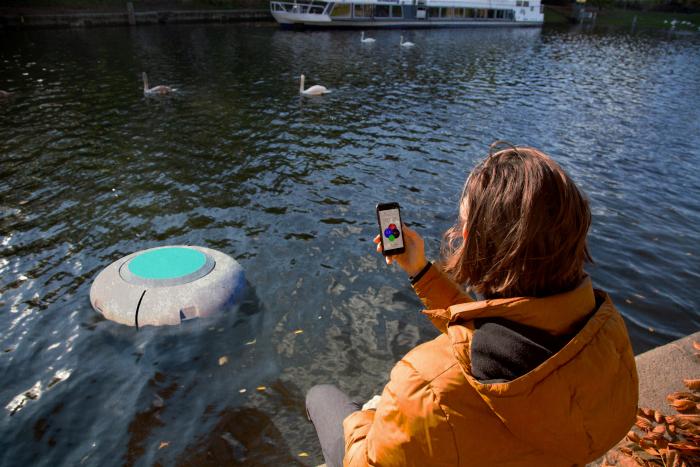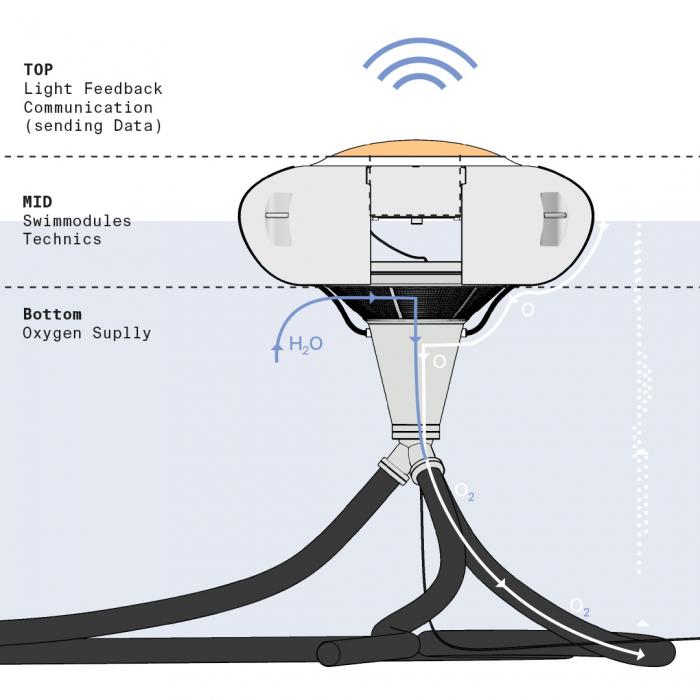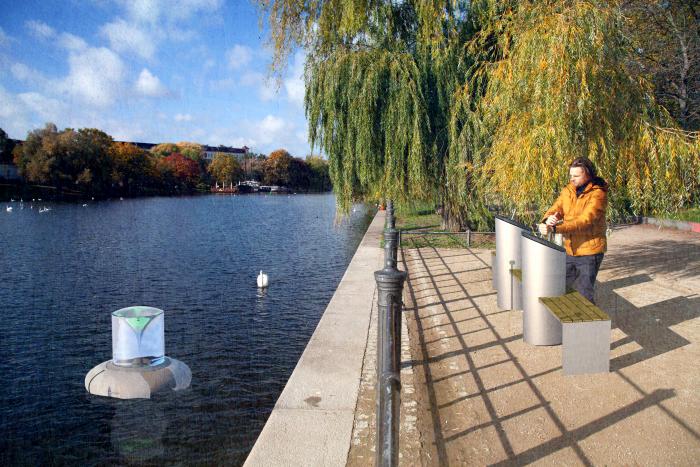How can a river be given its own political voice? The planet-centric project "SpreeBerlin" explores the relationship between Berlin and the Spree, considering the connections between the urban space, citizens, and the water. An oxygen-pumping measuring buoy is connected to a website, providing a direct interface to engage with the river and its potential. By combining art, technology, and science, the project offers a holistic solution to the various problems surrounding the river's ecosystem.
In the context of the climate crisis and the accompanying social change, the project examines the relationship between Berlin and the Spree, the urban space, the citizens and the body of water. How can the river be given its own "political" voice and what can contribute to creating more awareness of the Spree and the influence of humans? With the help of the buoy developed in the project, the body of water draws attention to pollution. Digital tools and media such as measuring devices and website, record the actual state of the river and communicate this to citizens* in an accessible way. Exciting historical and current articles around the topic are also presented. A future layer on the website illustrates how the city could change for the better with the help of the river and inspires citizens to take action. In the hot summer months, the buoy pumps oxygen into the river and supplies it to the Spree and its creatures. By combining art, technologies, and science, the planet-centric project serves as a poetic tool, providing a holistic and "green" solution to the various problems circulating around the Spree, essentially ensuing a healthier balance between all stakeholders involved
Please highlight how the concept/idea can be exemplary in this context
The main goal of the Spree Berlin project in terms of environmental sustainability focuses on two main areas. On the one hand, through a communicative element that sensibilize the relationship and the understanding of nature and the ecosystem of the river. For this purpose, the measuring buoy collects water data. These data are visible on the SpreeBerlin website next to exciting content, projects, and historical contributions. Inspiring narratives and utopias of an inclusive, sustainable, and renaturalized Stadtspree also inspire to dream and show, what potentials exist. This stimulates a moment of reconnecting, change of thinking, and action. In the best case, a transformative moment can arise.
Furthermore, the buoy developed in the project specifically addresses the oxygen problem of the Spree. This arises in the hot summer months due to eutrophication and causes massive fish mortality. The reason that Berlin does not have to suffer much dead fish every year is an oxygen-pumping diesel-powered boat, which costs the city half a million euros annually. The buoys are a green and sustainable alternative to that. They can be understood as an ecological stepping stone and provisional solution. Until the causes such as sewer overflows, river architecture, the use of waterways by shipping and traffic, roads directly on the river banks, climate change, fertilizer input from agriculture, or the sulfate pollution from coal mining have been eliminated. The main beneficiaries here are the fish and other creatures that depend on the oxygen in the water. All other stakeholders also benefit from the improvement of the ecosystem and the water quality. Thus, the buoy strengthens biodiversity and has a regenerative effect.
Please highlight how the concept/idea can be exemplary in this context
With the simple design, the buoys blend discreetly into the cityscape. Their shape and aesthetic are reminiscent of a jellyfish. The website is clearly and simply designed so that as many people as possible can use the service. A special creative focus is to make the voice of the river, graphically tangible.
The quality of experience is clearly determined by the interaction between people and nature. With the help of technical tools, sensual, as well as rational access can be created. A deeper understanding of the ecosystem, the involved actors, their interdependencies and the human influence emerges. This is one example of how we can use technology to connect and interact with our environment. It is about gaining a broader understanding of our actions and their consequences, as well as giving more attention and rights to non-human actors. Solutions that on the one hand concretely address an existing problem, implement regenerative structures, and at the same time show us the positive consequences and increased quality of life that come with a new understanding and action.
Example scenario; If you go for a walk along the river, you will notice the buoys. By day, through a simple but appealing design, by night, via an environmentally friendly light feedback. At certain sections of the riverbank, information boards explicitly point out the buoys and the associated web application. The buoys are powered by green electricity, either through the cities power system or a few solar cells connected. A possible application scenario is the activation of the oxygen function by stepping on a cardio device on the river bank. This also creates direct interaction with the buoy and also with the river, coupled to physical activity. Through the use and the technical aids, an interaction is created, that creates a deeper feeling of awareness and sensitivity of care.
Please highlight how the concept/idea can be exemplary in this context
The planet-centric approach of the project not only puts a special focus on inclusion, it makes it the central entry point of the design process. The developed concept emerged from an extensive problem analysis that considers the ecological as well as the economic agents involved. The buoys and website are accessible and usable for all citizens and visitors of the city. If a smartphone or internet access is not available, information about the project and ecosystem can also be found at specific riverbank locations. With the help of the future layer on the website, a possible, positive image of the Spree is drawn, which is inclusive and accessible for all. More open spaces for flora and fauna, but also recreational places for city dwellers. Suggestions are made for an ecological redesign and possible bathing places that are free of sewage and polluted banks. Thus, the project calls for change and makes this tangible through visualization. Currently, the waterways are unfortunately reserved exclusively for shipping and also many shore sites remain totally unused or are exploited for urban traffic. In its development phase, the project is understood as a discursive design project. It means that the findings and the current state of the art will be shared with the community in workshops and exhibitions, put up for discussion and further development. This creates dialogue and knowledge transfer within the process. It is very valuable and enriching for everyone involved. This way, the project was already shared and debated in a wide variety of formats such as:
SynchroniCities exhibition
Donut Berlin
Workshop: Planet Centric Design
Workshop: SpreeVision 01-03
Podcast at VHS Berlin
Instagram Account
Interview Salonfähig
TransformingCities Article
SummerSchool CityLab
TU Course
GermanDesignGraduates
Another goal regarding inclusion, openness, and community building is to offer the prototype measuring probe developed in the project as an OpenSource project
Please highlight how this approach can be exemplary
In summary, one can say, that the aspects of ecological sustainability, aesthetics, and quality of experience, as well as inclusion, are closely interwoven and make the SpreeBerlin project what it is. The starting point and motivation is to achieve a positive effect in an ecologically sustainable way. To offer a technical, concrete solution that simultaneously promotes change. By using the most sustainable material that is possible, regarding the current situation and its term of use, the project tries to make a difference in regard to conscious analytical production. With the help of aesthetics and design, experiential spaces are created, which communicate, reconnect, engage, motivate, regenerate and promote the potential of the transformation. By participating and actively addressing the urgent tasks of our time, local groups can work together on global issues, learning and sensing collectively, joining forces to make a change.
"SpreeBerlin" combines art, science & technology in a clever way and thus offers a concrete solution to a complex problem. At the same time, it touches the users and has a mobilizing effect. It combines different concepts and applications in one. Such as a measuring probe, oxygen pump, communication and transformation tool. These applications may already exist, but they are either not designed appealingly enough, very difficult to find, or just not implemented. "SpreeBerlin" connects the individual elements and brings them to a unique effect in a planet-centric context. This is the innovative character of the project. Basically, the concept could be transferred to any other city near a body of water and therefore has great potential to provide a healthier balance in other places as well.
The overall vision is a future where we live in climate-resilient, equitable, and inclusive cities, where healthy ecosystems provide optimal urban climates and leave space for non-human actors such as animals, plants, and "natural matter." Healthy cities are much freer from traffic and pollution, places of recreation and healing for their (human and non-human) inhabitants. As a result, the quality of life increases tremendously. The vision includes a new understanding of the environment, a "we-world" where we are part of a larger whole, moving away from a human-centric way of thinking and acting to a life- and planet-centric one. Strong symbioses and intelligent circulatory systems address our self-created problems. The boundaries between urban and rural, human and nature, technology, culture and biology are fluidly merging.
The Spree Berlin project is a possibility to get a big step closer to this vision and therefore there is a great motivation to push the project as far as possible. In the best case, we will be able to launch the first oxygen-pumping prototype in the foreseeable future (2-3 years). Funding formats such as EXIST or GreenTechSolutions could be considered for this process. 2022-23 could be used as a final research process and preparation for this step.
The project development can be divided into three areas;
Development of the buoy;
Development of the digital platform SpreeBerlin.de;
and communication, workshops, and think tanks.
The project, which was originally created in 2020 as a final thesis in design at the Weißensee School of Art, has received a lot of positive feedback in 2021/22 and has been able to gain a variety of local collaborations. This network includes; Wissenschaft im Dialog (BMBF), TU-Berlin, B-Part Berlin, VHS Mitte Berlin, Leuphana Utopia Conference, Fraunhofer Institut WKI, CityLab Berlin, OpenNext!, GDG & Donut Berlin.
In June 2022-23, with the help of funding from the NEW EUROPEAN BAUHAUS, the ongoing processes and collaborations could be completed and further developed.
Website - The re-design for the website will be implemented and programmed to be fully functional. The appropriate project partners are already in place for this.
Buoys - In 2022 the first measuring probe will be launched and tested as a prototype. The probe will then send the data to the website. A mycelium material for possible floating blogs will also be tested then. A very important step is an intensive study of the oxygen pumping function. With the TU Berlin as a cooperation partner, a water technology master student will focus on this topic for his/her thesis analyzing the open, technical questions
Communication - During these development cycles, the project will be communicated and further developed with the community via exhibitions and workshops. This is especially related to the website and its content. In this way, further research, stories, and projects can be collected and additional future narratives of a healthy spree collectively developed and visualized. In this context, an expert think tank is also planned, which will bring together cross-disciplinary experts on the topic of the Spree, the river, and water quality, in order to jointly identify the possibilities, technologies, and steps that are needed to unleash the full potential of the ecosystem in Berlin. The results could be presented to politicians and the public as an irresistible offer.
@Kukula, 2022
Content licensed to the European Union.




